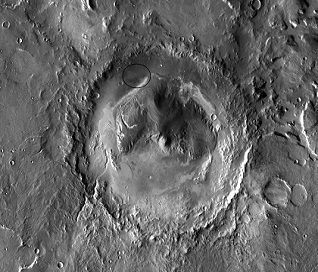Project Requirements
Below are the major requirements for the proposed system. Also a a pdf of the requirements document can be seen and downloaded here.


Functional Requirements
HiRISE and CTX
The system shall use the data sets provided by the HiRISE and the CTX instruments as the primary input for the tool. These datasets are provided to the public as JPEG2000 (JP2) images. As a consequence, any preprocessing of the images will require adherence to JP2 specifications.
a. The HiRISE (High Resolution Imaging Science Experiment) provides high resolution (25 cm/pixel) images of Mars’ surface.
b. The CTX (context camera) provides a more general overview of the surface at 6m/pixel.
Mars Orbital Datasets
The system shall allow users to be able to load and georeference multiple Mars orbital datasets, identify terrain types and features, and automatically map similar features across multiple input images.
Image Mapping
The system shall use HiRISE and CTX to present three Reduced Data Record (RDR) products conforming to Planetary Data System (PDS) standards.
a. HiRISE consists of two distinct RDRs. The first being a singlecolor RDR created from redfiltered cameras with a pixel width of 20,048. The second is a threecolor product which is a composite of red, bluegreen, and nearinfrared cameras with a pixel width of 4,048. Image data shall be combined to maximize available dataset.
b. In contrast to HiRISE, the CTX camera has a comparably lower resolution.This necessitates a manytoone and onetomany mapping algorithm to associate pixel information between the HiRISE and CTX RDRs.
Artificial Neural Network
Due to the size and complexity of input RDRs, the system shall use an Artificial Neural Network (ANN) in order to minimize time required to map terrain types. A Convolutional Neural Network (CNN) which is the neural network often used for image recognition and that served as the inspiration for this project. [3] CNNs are multilayer perceptrons that mimic visual perception by overlapping information segments. This also minimizes the need for image preprocessing. The ability to supervise training of the neural network layer by layer has made the CNN the prime candidate to implement neural network functionality required by the sponsor.
Training Datasets
CNNs are a type of feedforward neural network, though powerful, they require relatively large datasets to adequately train the neural network on. To circumvent this issue, the system shall need tools to generate realistic and reliably labelled training datasets as the initial training dataset provided by the sponsor will be small. Mimicry of training datasets will shall utilize the following techniques stochastic downsampling, orientation inversion, and image reorganization.
Image Post-Processing
The system shall use side channel spatial information such as transparency and alpha planes, which are useful for transmitting information for processing the image for display, print, or editing. This will be utilized to maintain neural network predictions inside the output RDR, such as marking the area of interest in the transparency plane, without compromising the input RDR.
Algorithm Performance
The system shall be able to assess how well the algorithm performed by comparing the correctness of the identified terrain with the results of a humangenerated map.
Robustness
The system shall be designed to handle error conditions easily, without failure. Such conditions include a tolerance of invalid datasets (non HiRISE/CTX produced data sets), unexpected operating conditions, and overfitting within machine learning algorithms.